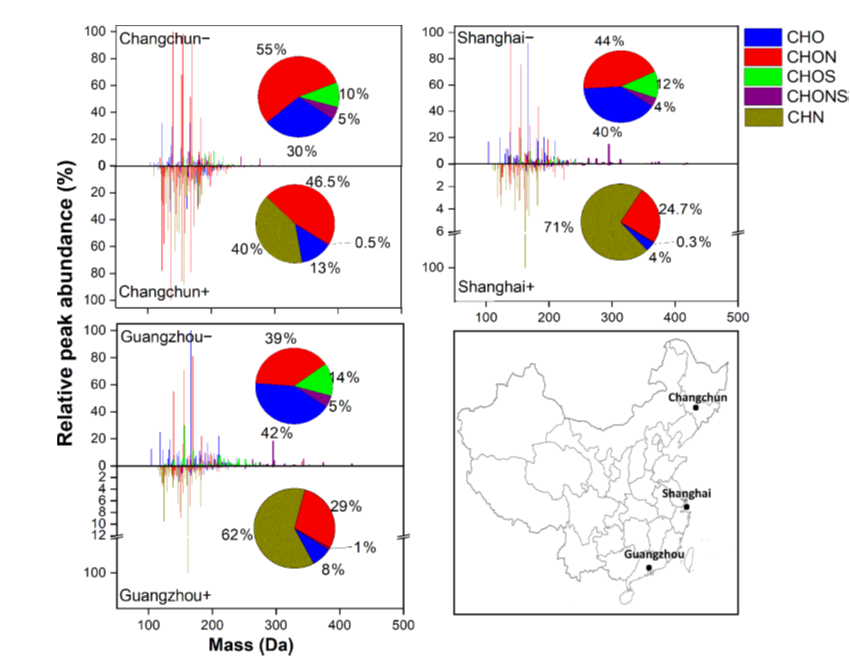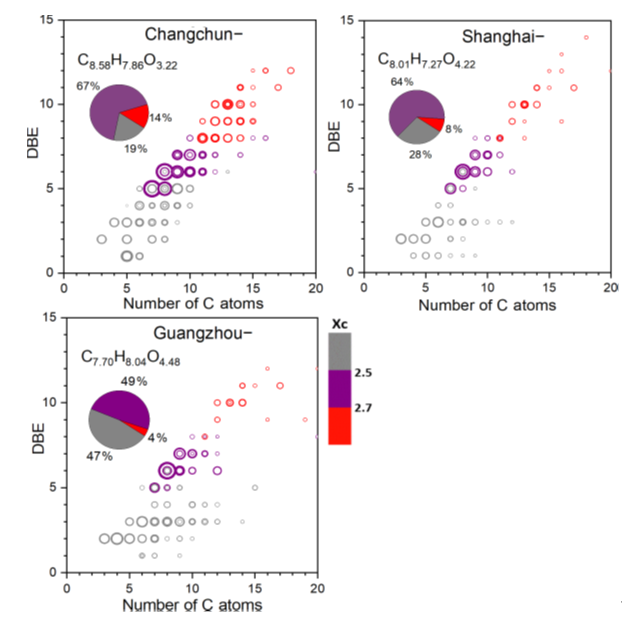Kai Wang, Ru-Jin Huang*, Martin Brüggemann, Yun Zhang, Lu Yang, Haiyan Ni, Jie Guo1, Meng Wang, Jiajun Han, Merete Bilde, Marianne Glasius, and Thorsten Hoffmann*, Urban organic aerosol composition in eastern China differs from north to south: molecular insight from a liquid chromatography–mass spectrometry (Orbitrap) study, Atmos. Chem. Phys., 2021, 9089–9104.
Air pollution by particulate matter in China affects human health, the ecosystem and the climate. However, the chemical composition of particulate aerosol, especially of theorganic fraction, is still not well understood.
A research group led by Prof. HUANG Rujin from the Institute of Earth Environment (IEE) of the Chinese Academy of Sciences applied an ultrahigh-performance liquid chromatograph (UHPLC) coupled to a high-resolution Orbitrap mass spectrometer to investigated OA composition in three cities located in northeast, east and southeast China, namely Changchun, Shanghai and Guangzhou.
After nontarget screening including the assignment of molecular formulas, the compounds were classified into five groups based on their elemental composition, i.e., CHO, CHON, CHN, CHOS and CHONS. The CHO, CHON and CHN groups present the dominant signal abundances of 81 %–99.7% in the mass spectra and the majority of these compounds were assigned to mono- and polyaromatics, suggesting that anthropogenic emissions are a major source of urban OA in all three cities. However, the chemical characteristics of these compounds varied between the different cities. The degree of aromaticity and the number of polyaromatic compounds were substantially higher in samples from Changchun, which could be attributed to the large emissions from residential heating (i.e., coal combustion) during wintertime in northeast China. Moreover, the ESI- analysis showed higher H=C and O=C ratios for organic compounds in Shanghai and Guangzhou compared to samples from Changchun, indicating that OA undergoes more intense photochemical oxidation processes in lower-latitude regions of China and/or is affected to a larger degree by biogenic sources. The majority of sulfur-containing compounds (CHOS and CHONS) in all cities were assigned to aliphatic compounds with low degrees of unsaturation and aromaticity. Here again, samples from Shanghai and Guangzhou show a greater chemical similarity but differ largely from those from Changchun.
This study, published in Atmos. Chem. Phys., enhanced our understanding of the chemical properties of OA at molecular level and was profound for identifying the sources and atmospheric process of OA in different areas.

Figure 1. Mass spectra of detected organic compounds reconstructed from extracted ion chromatograms in ESI- and ESI+. The horizontal axis refers to the molecular mass (Da) of the identified species. The vertical axis refers to the relative peak abundance of each individual compound compared to the compound with the greatest peak abundance. The pie charts show the percentage of each organic compound subgroup (i.e., CHO, CHON, CHOS, CHONS and CHN) in each sample in terms of peak abundance. The map in the lower right corner shows the locations of these three megacities in China.

Figure 2. Double bond equivalent (DBE) versus carbon number for all CHO- compounds for all sample locations. The molecular formula represents the abundance-weighted average CHO- formula, and the area of the circles is proportional to the fourth root of the peak abundance of an individual compound (a diagram with circle areas related to the absolute peak abundances is presented in Fig. S2). The color bar denotes the aromaticity equivalent (gray with XC < 2:50, purple with 2:50 < XC < 2:70 and red with XC < 2:70). The pie charts show the percentage of each XC category (i.e., gray color-coded compounds, purple color-coded compounds and red color-coded compounds) in each sample in terms of peak abundance.

